battery TOYOTA FR-S 2015 Owners Manual (in English)
[x] Cancel search | Manufacturer: TOYOTA, Model Year: 2015, Model line: FR-S, Model: TOYOTA FR-S 2015Pages: 452, PDF Size: 9.97 MB
Page 4 of 452

TABLE OF CONTENTSIndex
4
4-3. Do-it-yourself
maintenance
Do-it-yourself service
precautions ...................... 264
Hood................................... 267
Positioning a floor jack ....... 269
Engine compartment .......... 271
Tires ................................... 284
Tire inflation pressure......... 291
Wheels ............................... 295
Air conditioning filter ........... 298
Electronic key battery ......... 301
Checking and replacing
fuses ................................ 303
Light bulbs .......................... 311
5-1. Essential information
Emergency flashers ........... 322
If your vehicle needs to be
towed ............................... 323
If you think something is
wrong ............................... 331
Fuel pump shut off
system .............................. 3325-2. Steps to take in an
emergency
If a warning light turns
on or a warning buzzer
sounds... .......................... 333
If you have a flat tire ........... 346
If the engine will not
start .................................. 357
If the shift lever cannot be
shifted from P ................... 360
If you lose your keys ........... 361
If the electronic key does
not operate properly ......... 362
If the battery is
discharged ........................ 366
If your vehicle
overheats .......................... 370
If the vehicle becomes
stuck ................................. 373
If your vehicle has to
be stopped in an
emergency........................ 375
6-1. Specifications
Maintenance data
(fuel, oil level, etc.) ........... 378
Fuel information .................. 390
Tire information................... 394
6-2. Customization
Customizable features ........ 407
5When trouble arises
6Vehicle specifications
Page 20 of 452
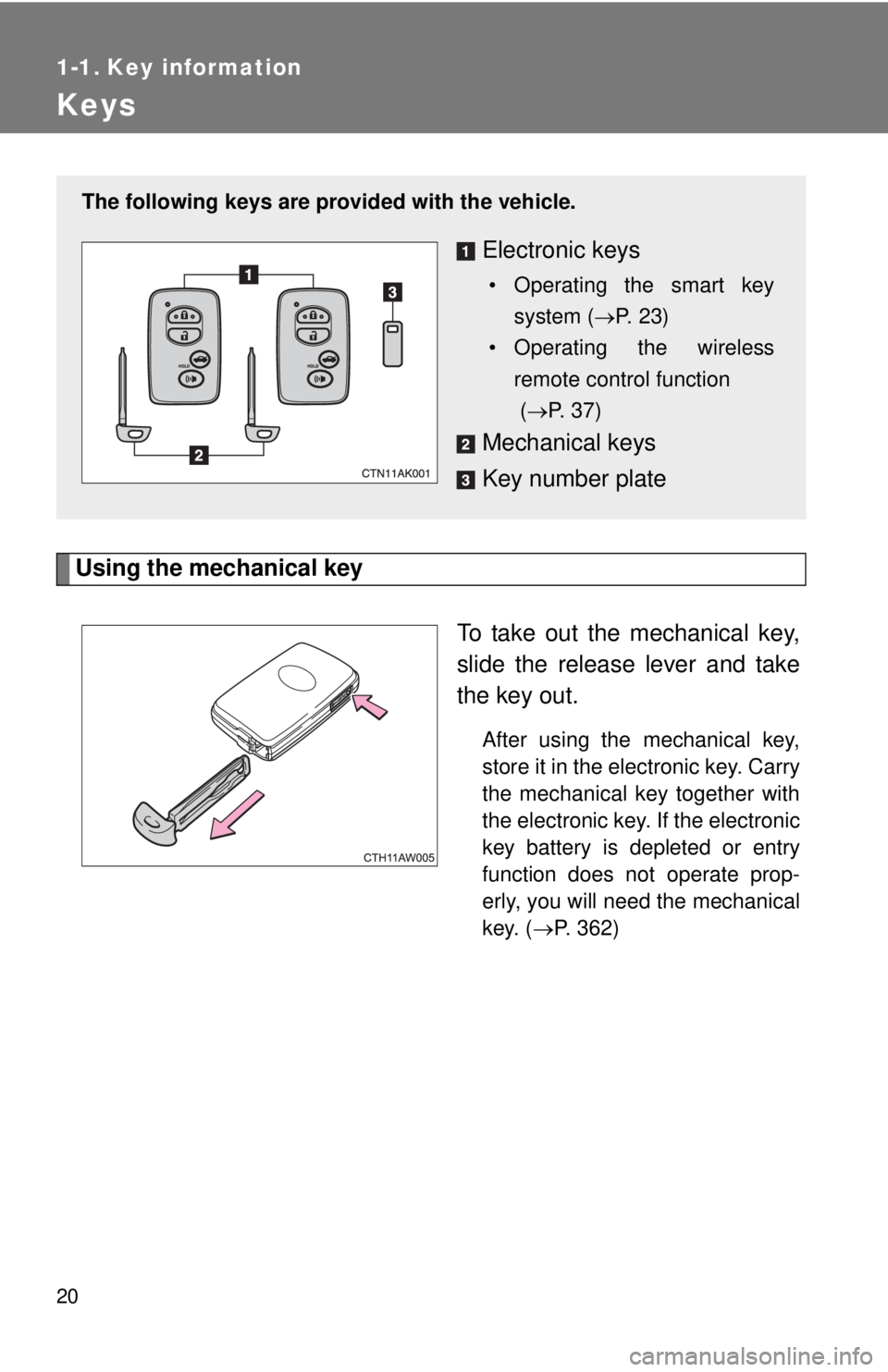
20
1-1. Key information
Keys
Using the mechanical key
To take out the mechanical key,
slide the release lever and take
the key out.
After using the mechanical key,
store it in the electronic key. Carry
the mechanical key together with
the electronic key. If the electronic
key battery is depleted or entry
function does not operate prop-
erly, you will need the mechanical
key. (P. 362)
The following keys are provided with the vehicle.
Electronic keys
• Operating the smart key
system (P. 23)
• Operating the wireless
remote control function
(P. 37)
Mechanical keys
Key number plate
Page 29 of 452

29 1-2. Opening, closing and locking the doors and trunk
1
Before driving
■Security feature
If a door is not opened within approximately 60 seconds after the vehicle is
unlocked, the security feature automatically locks the vehicle again. (How-
ever, depending on the location of the electronic key, the key may be
detected as being in the vehicle. In this case, vehicle may be unlocked.)
■Battery-saving function
The battery-saving function will be activated in order to prevent the elec-
tronic key battery and the vehicle battery from being discharged while the
vehicle is not in operation for a long time.
●In the following situations, the smart key system may take some time to
unlock the doors.
• The electronic key has been left in an area of approximately 6 ft. (2 m)
of the outside of the vehicle for 10 minutes or longer.
• The smart key system has not been used for 5 days or longer.
●If the smart key system has not been used for 14 days or longer, the
doors cannot be unlocked at any door except the driver’s door.
In this case, take hold of the driver’s door handle, or use the wireless
remote control or the mechanical key, to unlock the doors.
Page 30 of 452

30 1-2. Opening, closing and locking the doors and trunk
■Conditions affecting operation
The smart key system uses weak radio waves. In the following situations,
the communication between the electronic key and the vehicle may be
affected, preventing the smart key system, wireless remote control and
engine immobilizer system from operating properly.
(Way of coping P. 362)
●When the electronic key battery is depleted
●Near a TV tower, electric power plant, gas station, radio station, large dis-
play, airport or other facility that generates strong radio waves or electri-
cal noise
●When the electronic key is in contact with, or is covered by the following
metallic objects
• Cards to which aluminum foil is attached
• Cigarette boxes that have aluminum foil inside
• Metallic wallets or bags
• Coins
• Hand warmers made of metal
• Media such as CDs and DVDs
●When other wireless keys (that emit radio waves) are being used nearby
●When carrying the electronic key together with the following devices that
emit radio waves
• A portable radio, cellular phone, cordless phone or other wireless com-
munication device
• Another vehicle's electronic key or a wireless key that emits radio
waves
• Personal computers or personal digital assistants (PDAs)
• Digital audio players
• Portable game systems
●If window tint with a metallic content or metallic objects are attached to
the rear window
●When the electronic key is placed near a battery charger or electronic
devices
Page 34 of 452

34 1-2. Opening, closing and locking the doors and trunk
■Electronic key battery depletion
●The standard battery life is 1 to 2 years.
●If the battery becomes low, an alarm will sound in the cabin when the
engine stops. (P. 343)
●As the electronic key always receives radio waves, the battery will
become depleted even if the electronic key is not used. The following
symptoms indicate that the electronic key battery may be depleted.
Replace the battery when necessary. (P. 301)
• The smart key system or the wireless remote control does not operate.
• The detection area becomes smaller.
• The LED indicator on the key surface does not turn on.
●To avoid serious deterioration, do not leave the electronic key close to
any of the following electrical appliances that produce a magnetic field:
•TVs
• Personal computers
• Cellular phones, cordless phones and battery chargers
• Recharging cellular phones or cordless phones
• Induction cookers
• Table lamps
■When the electronic key battery is fully depleted
P. 301
■If the smart key system has been deactivated in a customized setting
●Locking and unlocking the doors, unlocking the trunk: Use the wireless
remote control or mechanical key. (P. 37, 362)
●Starting the engine and changing “ENGINE START STOP” switch
modes: P. 3 6 3
●Stopping the engine: P. 365
■Customization that can be configured at Scion dealer
Settings (e.g. smart key system) can be changed.
(Customizable features: P. 407)
Page 39 of 452

39 1-2. Opening, closing and locking the doors and trunk
1
Before driving
■If the wireless remote control does not operate properly
Locking and unlocking the doors, unlocking the trunk: Use the mechanical
key. (P. 362)
■Key battery depletion
P. 3 4
■When the electronic key battery is fully depleted
P. 301
■Confirmation of the registered key number
The number of keys already registered to the vehicle can be confirmed. Ask
your Scion dealer for details.
■Customization that can be configured at your Scion dealer
Settings (e.g. wireless remote control system) can be changed.
(Customizable features P. 407)
Page 41 of 452
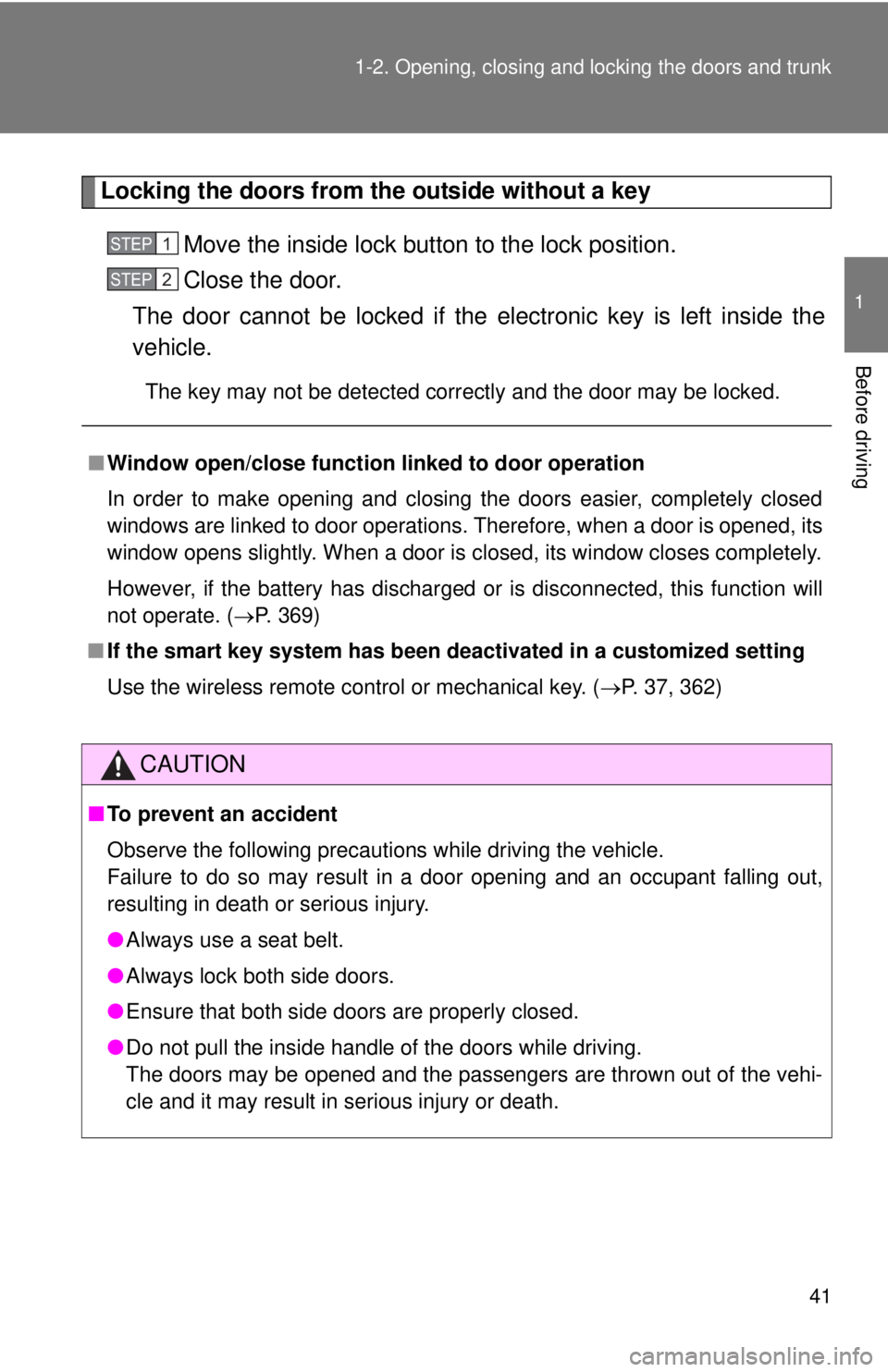
41 1-2. Opening, closing and locking the doors and trunk
1
Before driving
Locking the doors from the outside without a key
Move the inside lock button to the lock position.
Close the door.
The door cannot be locked if the electronic key is left inside the
vehicle.
The key may not be detected correctly and the door may be locked.
■Window open/close function linked to door operation
In order to make opening and closing the doors easier, completely closed
windows are linked to door operations. Therefore, when a door is opened, its
window opens slightly. When a door is closed, its window closes completely.
However, if the battery has discharged or is disconnected, this function will
not operate. (P. 369)
■If the smart key system has been deactivated in a customized setting
Use the wireless remote control or mechanical key. (P. 37, 362)
CAUTION
■To prevent an accident
Observe the following precautions while driving the vehicle.
Failure to do so may result in a door opening and an occupant falling out,
resulting in death or serious injury.
●Always use a seat belt.
●Always lock both side doors.
●Ensure that both side doors are properly closed.
●Do not pull the inside handle of the doors while driving.
The doors may be opened and the passengers are thrown out of the vehi-
cle and it may result in serious injury or death.
STEP 1
STEP 2
Page 78 of 452
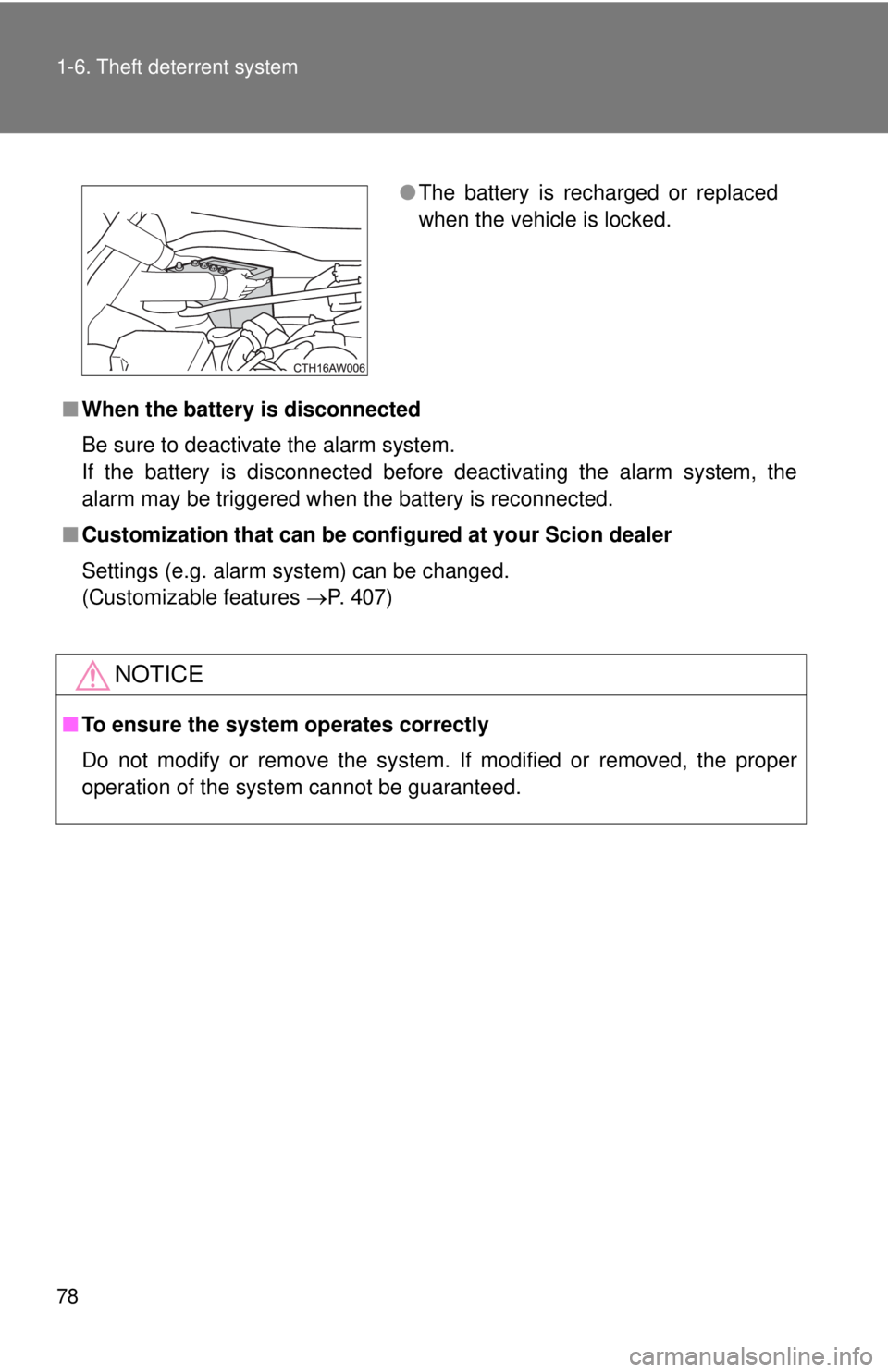
78 1-6. Theft deterrent system
■When the battery is disconnected
Be sure to deactivate the alarm system.
If the battery is disconnected before deactivating the alarm system, the
alarm may be triggered when the battery is reconnected.
■Customization that can be configured at your Scion dealer
Settings (e.g. alarm system) can be changed.
(Customizable features P. 407)
NOTICE
■To ensure the system operates correctly
Do not modify or remove the system. If modified or removed, the proper
operation of the system cannot be guaranteed.
●The battery is recharged or replaced
when the vehicle is locked.
Page 157 of 452
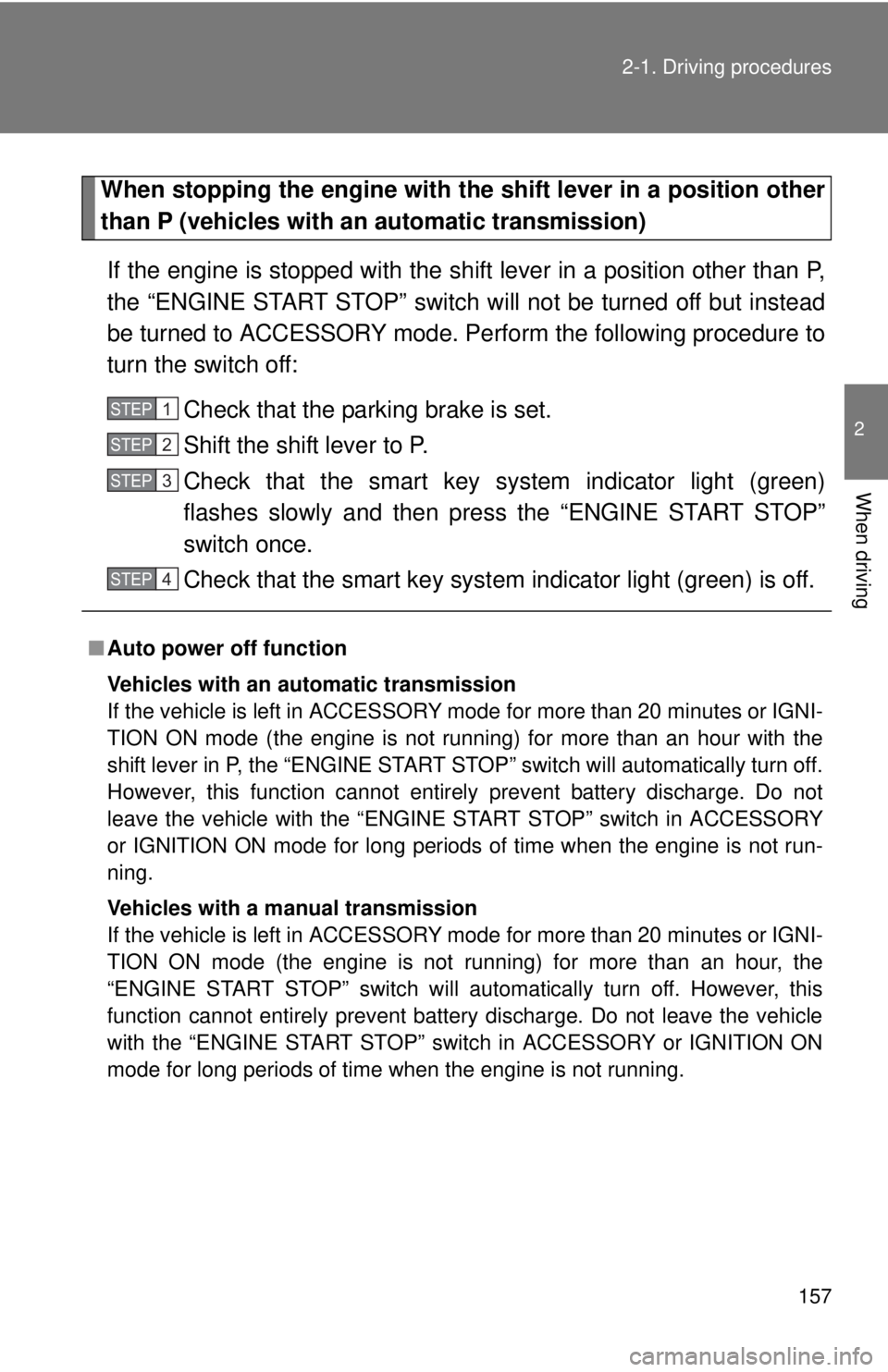
157 2-1. Driving procedures
2
When driving
When stopping the engine with the shift lever in a position other
than P (vehicles with an automatic transmission)
If the engine is stopped with the shift lever in a position other than P,
the “ENGINE START STOP” switch will not be turned off but instead
be turned to ACCESSORY mode. Perform the following procedure to
turn the switch off:
Check that the parking brake is set.
Shift the shift lever to P.
Check that the smart key system indicator light (green)
flashes slowly and then press the “ENGINE START STOP”
switch once.
Check that the smart key system indicator light (green) is off.
■Auto power off function
Vehicles with an automatic transmission
If the vehicle is left in ACCESSORY mode for more than 20 minutes or IGNI-
TION ON mode (the engine is not running) for more than an hour with the
shift lever in P, the “ENGINE START STOP” switch will automatically turn off.
However, this function cannot entirely prevent battery discharge. Do not
leave the vehicle with the “ENGINE START STOP” switch in ACCESSORY
or IGNITION ON mode for long periods of time when the engine is not run-
ning.
Vehicles with a manual transmission
If the vehicle is left in ACCESSORY mode for more than 20 minutes or IGNI-
TION ON mode (the engine is not running) for more than an hour, the
“ENGINE START STOP” switch will automatically turn off. However, this
function cannot entirely prevent battery discharge. Do not leave the vehicle
with the “ENGINE START STOP” switch in ACCESSORY or IGNITION ON
mode for long periods of time when the engine is not running.
STEP 1
STEP 2
STEP 3
STEP 4
Page 158 of 452
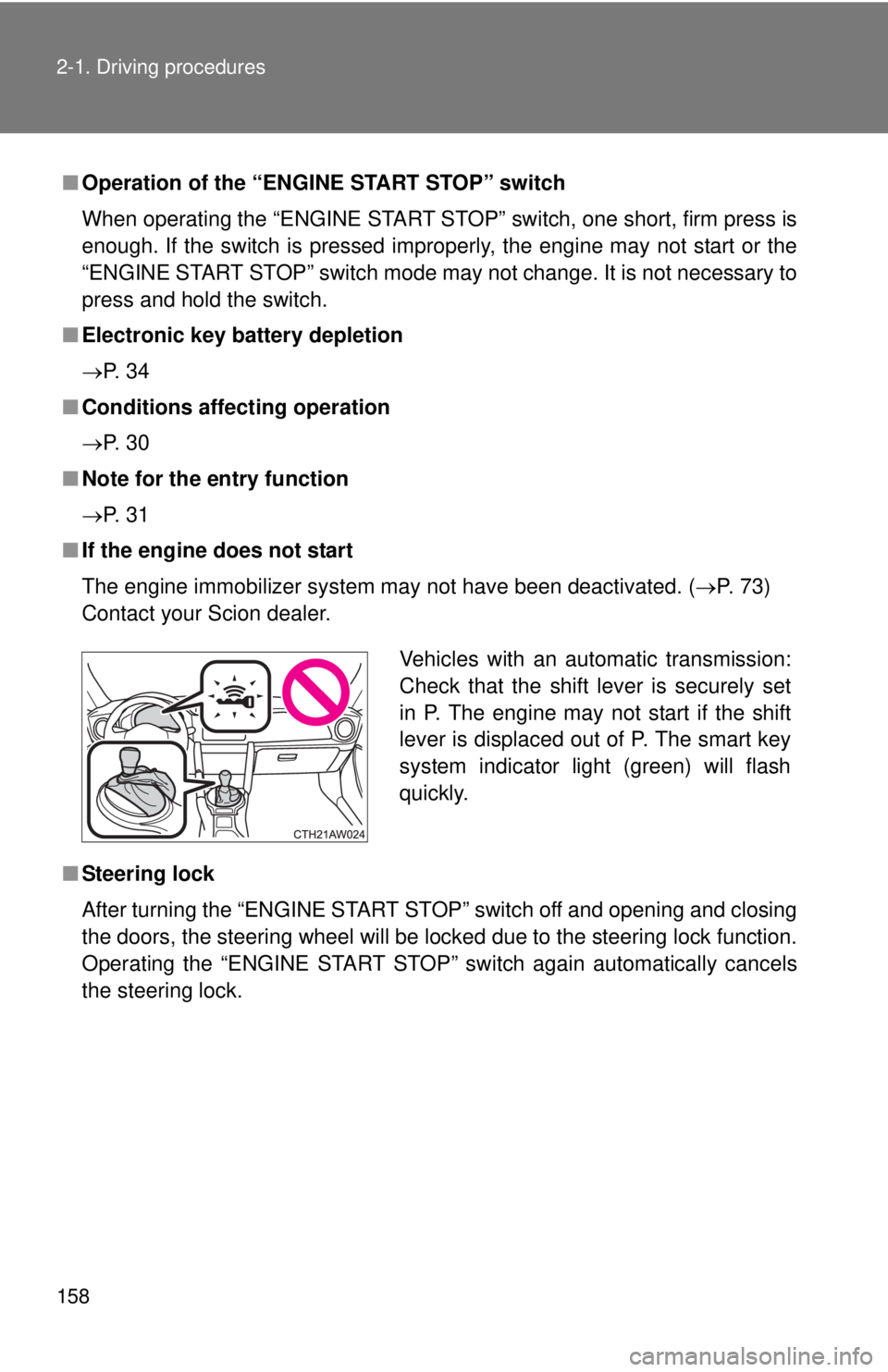
158 2-1. Driving procedures
■Operation of the “ENGINE START STOP” switch
When operating the “ENGINE START STOP” switch, one short, firm press is
enough. If the switch is pressed improperly, the engine may not start or the
“ENGINE START STOP” switch mode may not change. It is not necessary to
press and hold the switch.
■Electronic key battery depletion
P. 3 4
■Conditions affecting operation
P. 3 0
■Note for the entry function
P. 3 1
■If the engine does not start
The engine immobilizer system may not have been deactivated. (P. 73)
Contact your Scion dealer.
■Steering lock
After turning the “ENGINE START STOP” switch off and opening and closing
the doors, the steering wheel will be locked due to the steering lock function.
Operating the “ENGINE START STOP” switch again automatically cancels
the steering lock.
Vehicles with an automatic transmission:
Check that the shift lever is securely set
in P. The engine may not start if the shift
lever is displaced out of P. The smart key
system indicator light (green) will flash
quickly.